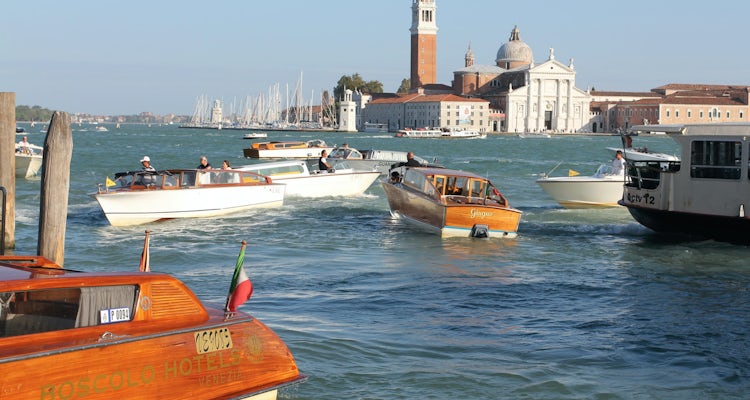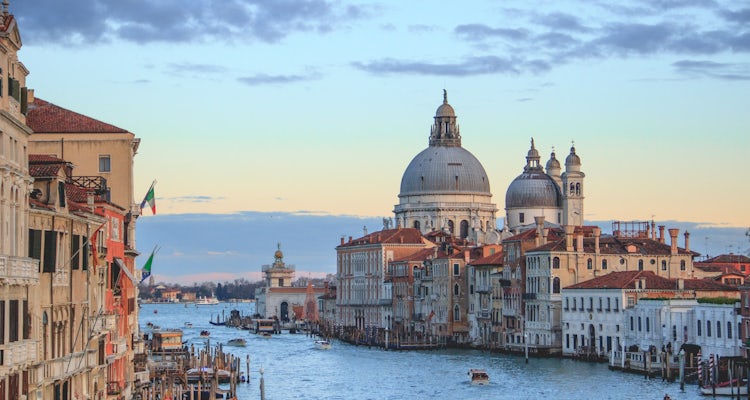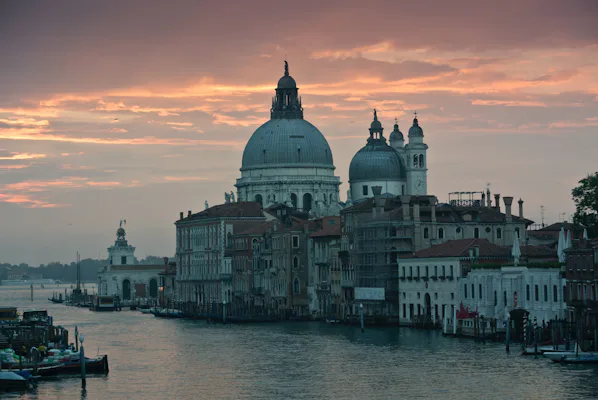Venice’s most treasured boulevard, the Grand Canal is a 3 km strip of glistening water dotted with gondolas, vaporettos, tragettis and many other water crafts. Considered Venice’s ‘busiest street’,the Canalazzo as it is commonly called divides the city of Venice into 2 halves. This truly Grand canal serpentines from the central neighbourhoods of Venice and ends near the St Mark’s square. In its course, it passes under 4 bridges crossing buzzing markets, well-manicured gardens and regal canal-front restaurants, lined by grand museums, churches and iconic structures. In essence, the Grand Canal not only connects the top attractions of Venice, it is a top attraction by itself.
The Grand Canal of Venice
Have you ever seen pictures so postcard perfect that you end up convincing yourself it’s a painting? Grand Canal is one of those surreal picturesque beauties you can’t believe exists.
The Grand Canal is flanked by a total of 170 structures, a mix of Byzantine Romanesque buildings, Renaissance Palazzos and Neoclassical mansions. Pastel yellows, mellow greens and creamy orange buildings rising out of clear blue water, cobbles streets lining its periphery and tourists and locals whizzing past its shore is a basic bird’s eye view of the Grand Canal.

This bustling canal is never idle. Being the artery of Venice, you have water crafts shuttling people at the oddest of hours simply because there is no other way to get around this Floating City. Be it the bedecked gondolas, the public vaporettos, the private acquei or the tragettis, the Grand Canal is perpetually astir. Before you get on your chosen mode of transport to glide on the Grand Canal, take a few minutes to consume this brewing commotion.
If you happen to cruise the Grand Canal around sunset, you are in for a soulful treat. In the backdrop of cotton candy sky, the sun’s soft yellow hues creates a golden glow so magical that the city looks akin heaven. Adding on to this beauty is the stirring reflection of the grandeur structures on the emerald water you are cruising on. You are not likely to forget this scenario for a long long time.
Evolution Of The Grand Canal - An Architectural Delight
The Grand Canal is believed to be a branch of the ancient Brenta River that opens into a lagoon. In the 10th century, the Byzantine Empire settled and sprung on the banks of the Grand Canal. Trading flourished due to the easy accessibility via sea and most of those who stayed by the peripheries of the canal were established merchants and traders.

By the 12th century, houses along the canal became ornate with Byzantine arches and loggias. The oldest building along the canal namely Ca’ da Mosto is a 13th century palazzo which flaunts the Venetian-Byzantine style of architecture. Cut to 15th century when the European Gothic style of construction spread across Europe like blazing fire and Venice too succumbed. The Ca d’Oro( House of Gold) plastered in bright colours with skinny arches and intricate carvings is a fine blend of Venetian Gothic architecture by the Canal.
The 16th century saw the Renaissance architecture creeping into buildings around Venice. Pastels were replaced by clean whites and windows started becoming curvy from its pointed stance. The Palazzo Dario and Palazzo Grimani are fine examples of the Classical Renaissance architecture. During this period, having a palace facing the Grand Canal was considered a status symbol.

By the 17th century, the Grand Canal was crowded enough but certain Baroque styled constructions made its way to the pier. This prolific era saw the creation of the Santa Maria di Nazareth Church and the world renowned Santa Maria della Salute Basilica. These were perhaps the last few structures to adorn the Grand Canal because by the 18th century, construction along with Grand Canal saw a complete halt.
Ever since, it has just been restoration and preservation works to maintain these splendid structures that are the pride of Venice.
What Are The Best Ways To Cruise The Grand Canal?
Grand Canal Gondola Ride with Romantic Serenade and Dinner

- Enjoy a traditional serenade on a Gondola ride on the Grand Canal and venture into the meandering venetian canals during your ride.
- Explore parts of the Grand Canal and other hidden canals under the magical evening sky
- Savor authentic Italian cuisine with fresh seafood and local delicacies at a fine dine restaurant
- Lay your eyes on important landmarks like the Accademia Bridge, La Fenice Theatre, St Mark's Basilica and more while you're traversing the Grand Canal.
- Be transported to a time in history without the rush and noise of vehicular traffic and simply the sounds of the water and people enjoying their evenings.
Grand Canal Gondola Ride With Serenade

- Explore the lifeline of the city, the web of canals that helped turn Venice into an economic and cultural powerhouse, elevating the city to the status of ‘La Dominante’.
- Enjoy 30 minutes of blissful cruise on the Grand Canal with your gondolier and guide enlightening you with lores, facts and stories of yore
- Entry for children below the age of 2 is free, as long as the child does not occupy a seat of his/her own. Children over the age of 2 pay full price.
Grand Canal Gondola Ride with Audio-Guide

- Enjoy the grandeur of Venice through its canals in the iconic gondola with skip the line tickets on a 30-minute shared gondola ride.
- Explore the waterways and the celebrated parts of the Grand Canal including the Peggy Guggenheim Collection, Desdemona’s House and Mozart’s House.
- Immerse yourself in the opulence of Venice and learn about its vibrant history with a handy multilingual audio guide app.
Top 5 Attractions Along The Grand Canal
The Grand Canal stretches across the whole city in the shape of an inverted S. It is lined by numerous structures of importance like churches, government offices, museums, palaces, historical markets and more. Make sure you don't blink too often lest you miss a wonderous building. Amongst the umpteen structures, here's a list of 5 attractions along Grand Canal you absolutely cannot miss.
Santa Maria Della Saluta

The monumental baroque of Santa Maria Della Saluta, commonly known as the Salute is the most impressive structure on the Grand Canal. This church dedicated to the Lady of Health was erected as a votive offering for the city’s deliverance from the plague outbreak in 1630. The massive dome is sure to catch your attention from even the furthest point on the Grand Canal.
Peggy Guggenheim Collection

This is a modern art museum housed in the Palazzo Venier dei Leoni, an 18th-century palace, which was home to the American heiress Peggy Guggenheim for almost 30 years. It is a low white contemporary structure that is always bustling with tourists and if you crane your neck enough, you may see a few prominent sculpts of art from around the world.
Palazzo Corner della Ca' Grand

Bang opposite the Peggy Guggenheim's Collection, you will see a fine example of Renaissance architecture. This is the Corner della Ca' Grande built in 1545 by Italian master sculptor Jacopo Sansovino, for the powerful Cornaro family. It was built in order to showcase the Carnaro family’s status. Notice the Ionic columns on the first floor and Corinthian columns on the second while you cross by this grand palazzo.
Ca' d'Oro

The House of Gold is an exemplary example of Venetian Gothic architecture and considered one of the most eye worthy sights on the Canal. Though the Ca' d'Oro has lost its original lustre, its shimmering mosaic and gold might cause you to flinch a little. The interiors of this masterpiece houses a museum which illustrates the lives of the Venetian Nobles during the Middle Ages.
San Stae


Built in 1678, this church was built in shape of a Greek Cross and the facade that you see from the Grand Canal was built 30 years after its original construction by Domenico Rossi. This finely embellished roccocò styles structure was initially built as dedication to Saint Eustacchio. San Stae is a part of the Chorus Circuit and houses the tomb of the Mocenigo Family, an affluent Venetian family who gave 7 Doges to the Republic.
Learn About The 4 Bridges Connecting The Grand Canal
On the Grand Canal, there are 4 bridges connecting parts of it for easy pedestrian access. Each of these have been built in different eras and are integral connecting points. Don't forget to notice these 4 canals during your cruise.
Ponte Di Rialto

The Rialto Bridge is the first and oldest bridge connecting San Marco and San Polo. It took 3 years to erect this ornate structure engraved with Istrian stone reliefs depicting St Mark, St Theodore and the Annunciation.
Ponte dell’Accademia
This bridge is a wooden bridge which derives its name from the Accademia galleries close by and connects Dorsoduro and Saint Mark's district and is very close to the Peggy Guggenheim Museum as well. Ponte dell’Accademia has a terrific vantage point overlooking the Grand Canal and is hence considered a shutterbug's paradise.
Ponte degli Scalzi

Ponte degli Scalzi translates to Bridge of Barefoot Monks and is a stone arch bridge connecting two frequented areas - Santa Croce and Cannaregio.If you arrive by bus or train you are likely to use this bridge to move into the city as it connects the Santa Lucia Railway Station and Piazzale Roma Bus Station.
Ponte della Costituzione
TThe last and latest bridge connecting the Grand Canal is Ponte della Costituzione commonly called Calatrava Bridge. It crossed the Grand Canal at the terminus of 3 modes of transport - Buses, Boats and Railways. It is a long, sweeping curve of glass and steel designed to complement both the historic buildings on the Piazzale Roma side of the canal and the 1950s modernity of Venice's main railway station. Though it is considered the gateway to Venice, it has received much criticism as it is not luggage and wheelchair friendly.
Insider Tips For The Perfect Grand Canal Ride
- The Grand Canal is lovely year around, both by day and night. So whenever you go, rest assured it will be a feast for your senses.
- Booking tickets online will save you the hassle of standing in mile long queues.
- Combo tickets with a serenade, dinner or walking tour works out economically and enhances your experience further.
- Taking the public vaporettos to cruise the Grand Canal for pleasure is least advised due to the incessant stops and crowd.
- A private taxi, a shared boat for your family/friends alone or gondolas are the best modes to cruise the Grand Canal as you can travel into lesser visited parts of the Canal and experience calming solace.
- It's best to avoid cruising the Grand Canal during the community hours in the morning (7 am - 9 am) and evening( 6 pm - 7 pm).
FAQs: Grand Canal Venice
The Grand Canal is famous worldwide for the centuries-old palaces which stand on both sides of the water. Most of them date from the 13th to the 18th century, a time in which existed the Venetian Republic. These magnificent buildings show the wealth Venetian families had at the time of the powerful Venetian Republic.
The Grand Canal of Venice, also known as Canalazzo, is the most important waterway sweeping through this amazing city. While the ancient canal measures 3.8 kilometres long, it snakes through Venice in a large S shape and splits the city in two sides.
Grand Canal, Italian Canale Grande, main waterway of Venice, Italy, following a natural channel that traces a reverse-S course from San Marco Basilica to Santa Chiara Church and divides the city into two parts.
The Grand Canal, also known as canalazzo is the main channel of transportation in Venice. It starts from the Saints Mark's basin and ends at a lake near the Santa Lucia railway station.
Most of Venice's sewage goes directly into the city's canals. Flush a toilet, and someone crossing a bridge or cruising up a side canal by gondola may notice a small swoosh of water emerging from an opening in a brick wall.
So, can you swim in the Venice canals? The simple answer is: no, you are not allowed to swim in the Venice canals, nor in any other place in the historic center of Venice.
Either side of the Grand Canal private buildings front the waterfront, there is no footpath alongside the Grand Canal. You can walk between Santa Lucia Railway Station and St Mark's Square and view the Rialto Bridge on the way, but your only glimpse of the Grand Canal will be at Rialto Bridge.
The Grand Canal played a huge role in reunifying north and south China. The canal was built by conscripted laborers and connected the Yellow River in the north with the Yangtze River in the south, which made it much easier to transport grain from the south to the centers of political and military power in north China.


